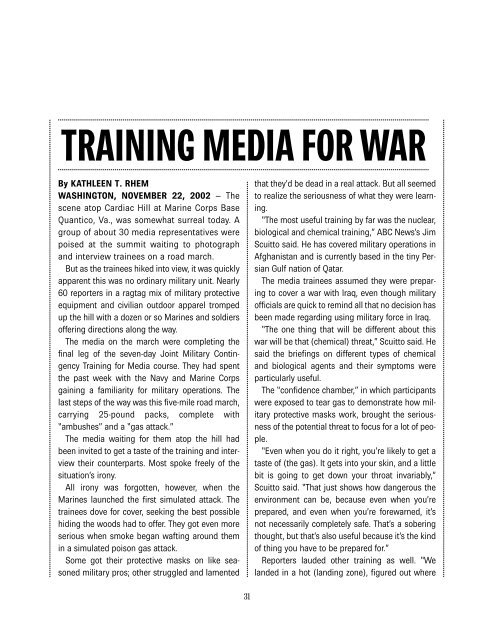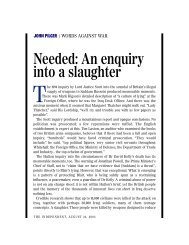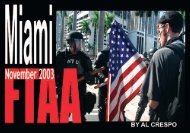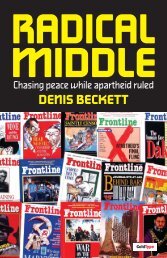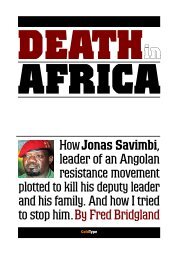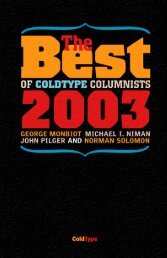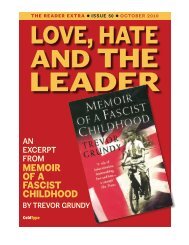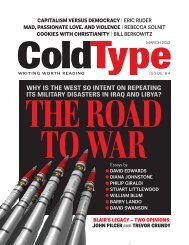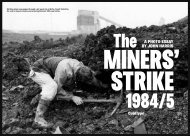UPDATED - ColdType
UPDATED - ColdType
UPDATED - ColdType
- TAGS
- updated
- coldtype
- coldtype.net
Create successful ePaper yourself
Turn your PDF publications into a flip-book with our unique Google optimized e-Paper software.
TRAINING MEDIA FOR WAR<br />
By KATHLEEN T. RHEM<br />
WASHINGTON, NOVEMBER 22, 2002 – The<br />
scene atop Cardiac Hill at Marine Corps Base<br />
Quantico, Va., was somewhat surreal today. A<br />
group of about 30 media representatives were<br />
poised at the summit waiting to photograph<br />
and interview trainees on a road march.<br />
But as the trainees hiked into view, it was quickly<br />
apparent this was no ordinary military unit. Nearly<br />
60 reporters in a ragtag mix of military protective<br />
equipment and civilian outdoor apparel tromped<br />
up the hill with a dozen or so Marines and soldiers<br />
offering directions along the way.<br />
The media on the march were completing the<br />
final leg of the seven-day Joint Military Contingency<br />
Training for Media course. They had spent<br />
the past week with the Navy and Marine Corps<br />
gaining a familiarity for military operations. The<br />
last steps of the way was this five-mile road march,<br />
carrying 25-pound packs, complete with<br />
“ambushes” and a “gas attack.”<br />
The media waiting for them atop the hill had<br />
been invited to get a taste of the training and interview<br />
their counterparts. Most spoke freely of the<br />
situation’s irony.<br />
All irony was forgotten, however, when the<br />
Marines launched the first simulated attack. The<br />
trainees dove for cover, seeking the best possible<br />
hiding the woods had to offer. They got even more<br />
serious when smoke began wafting around them<br />
in a simulated poison gas attack.<br />
Some got their protective masks on like seasoned<br />
military pros; other struggled and lamented<br />
31<br />
that they’d be dead in a real attack. But all seemed<br />
to realize the seriousness of what they were learning.<br />
“The most useful training by far was the nuclear,<br />
biological and chemical training,” ABC News’s Jim<br />
Scuitto said. He has covered military operations in<br />
Afghanistan and is currently based in the tiny Persian<br />
Gulf nation of Qatar.<br />
The media trainees assumed they were preparing<br />
to cover a war with Iraq, even though military<br />
officials are quick to remind all that no decision has<br />
been made regarding using military force in Iraq.<br />
“The one thing that will be different about this<br />
war will be that (chemical) threat,” Scuitto said. He<br />
said the briefings on different types of chemical<br />
and biological agents and their symptoms were<br />
particularly useful.<br />
The “confidence chamber,” in which participants<br />
were exposed to tear gas to demonstrate how military<br />
protective masks work, brought the seriousness<br />
of the potential threat to focus for a lot of people.<br />
“Even when you do it right, you’re likely to get a<br />
taste of (the gas). It gets into your skin, and a little<br />
bit is going to get down your throat invariably,”<br />
Scuitto said. “That just shows how dangerous the<br />
environment can be, because even when you’re<br />
prepared, and even when you’re forewarned, it’s<br />
not necessarily completely safe. That’s a sobering<br />
thought, but that’s also useful because it’s the kind<br />
of thing you have to be prepared for.”<br />
Reporters lauded other training as well. “We<br />
landed in a hot (landing zone), figured out where


